A Comprehensive Analysis of the Federal Reserve System (ECON 430)
VerifiedAdded on 2022/10/11
|12
|2793
|50
Report
AI Summary
This report provides a comprehensive analysis of the Federal Reserve System, also known as "The Fed," the central bank of the United States. It begins with an introduction that highlights the Fed's crucial role in managing the US and global economies by controlling the money supply and supervising commercial banks. The report delves into the historical context of the Fed, tracing its origins to address bank failures and credit shortages. It examines the evolution of money and banking from the Stone Age to post-colonization America, emphasizing the factors that led to the establishment of the Federal Reserve System in 1913. The report then outlines the key functions of the Fed, including managing inflation through monetary policy, providing banking services, maintaining financial system stability, and supervising the banking system. It explores the Fed's use of liquidity tools, monetary policy, and its response to financial crises, such as the 2008 crisis, including the adoption of unconventional monetary policies like quantitative easing and forward guidance. The report concludes by summarizing the Fed's significant adaptations and adjustments to its frameworks and monetary policies over time, reflecting the evolving economic landscape and the changing needs of the financial system.
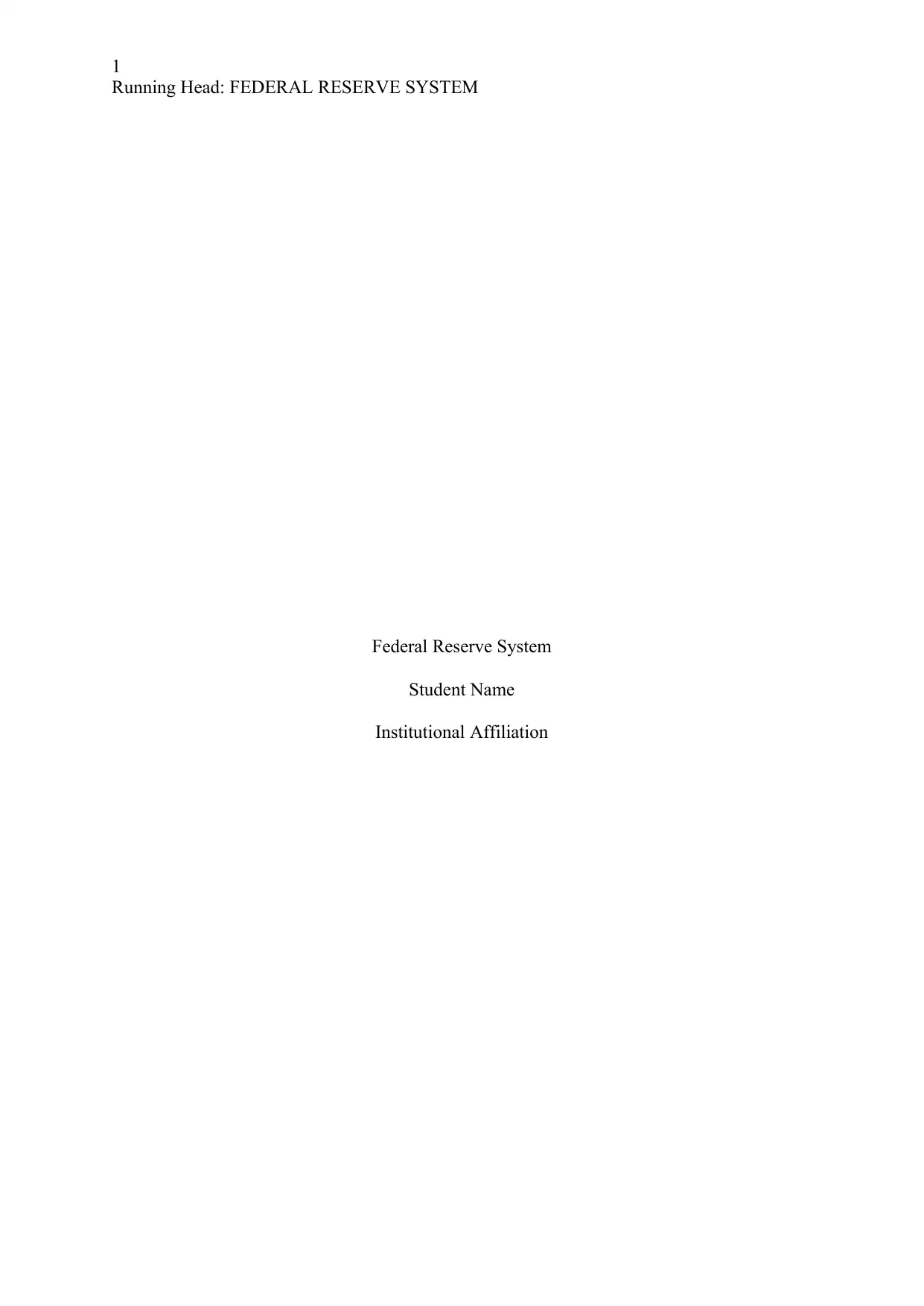
1
Running Head: FEDERAL RESERVE SYSTEM
Federal Reserve System
Student Name
Institutional Affiliation
Running Head: FEDERAL RESERVE SYSTEM
Federal Reserve System
Student Name
Institutional Affiliation
Paraphrase This Document
Need a fresh take? Get an instant paraphrase of this document with our AI Paraphraser
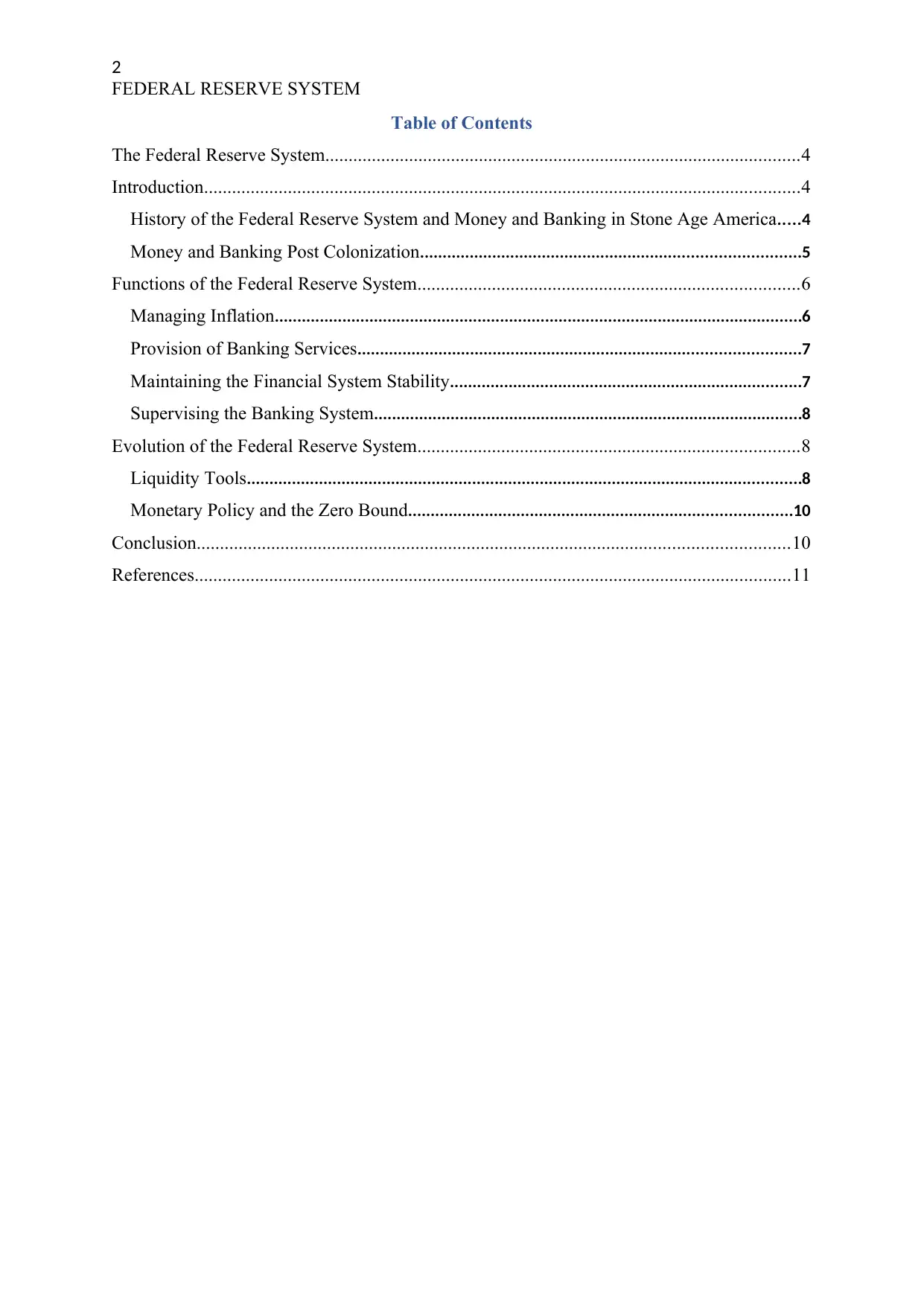
2
FEDERAL RESERVE SYSTEM
Table of Contents
The Federal Reserve System......................................................................................................4
Introduction................................................................................................................................4
History of the Federal Reserve System and Money and Banking in Stone Age America.....4
Money and Banking Post Colonization....................................................................................5
Functions of the Federal Reserve System..................................................................................6
Managing Inflation.....................................................................................................................6
Provision of Banking Services..................................................................................................7
Maintaining the Financial System Stability..............................................................................7
Supervising the Banking System...............................................................................................8
Evolution of the Federal Reserve System..................................................................................8
Liquidity Tools...........................................................................................................................8
Monetary Policy and the Zero Bound.....................................................................................10
Conclusion...............................................................................................................................10
References................................................................................................................................11
FEDERAL RESERVE SYSTEM
Table of Contents
The Federal Reserve System......................................................................................................4
Introduction................................................................................................................................4
History of the Federal Reserve System and Money and Banking in Stone Age America.....4
Money and Banking Post Colonization....................................................................................5
Functions of the Federal Reserve System..................................................................................6
Managing Inflation.....................................................................................................................6
Provision of Banking Services..................................................................................................7
Maintaining the Financial System Stability..............................................................................7
Supervising the Banking System...............................................................................................8
Evolution of the Federal Reserve System..................................................................................8
Liquidity Tools...........................................................................................................................8
Monetary Policy and the Zero Bound.....................................................................................10
Conclusion...............................................................................................................................10
References................................................................................................................................11
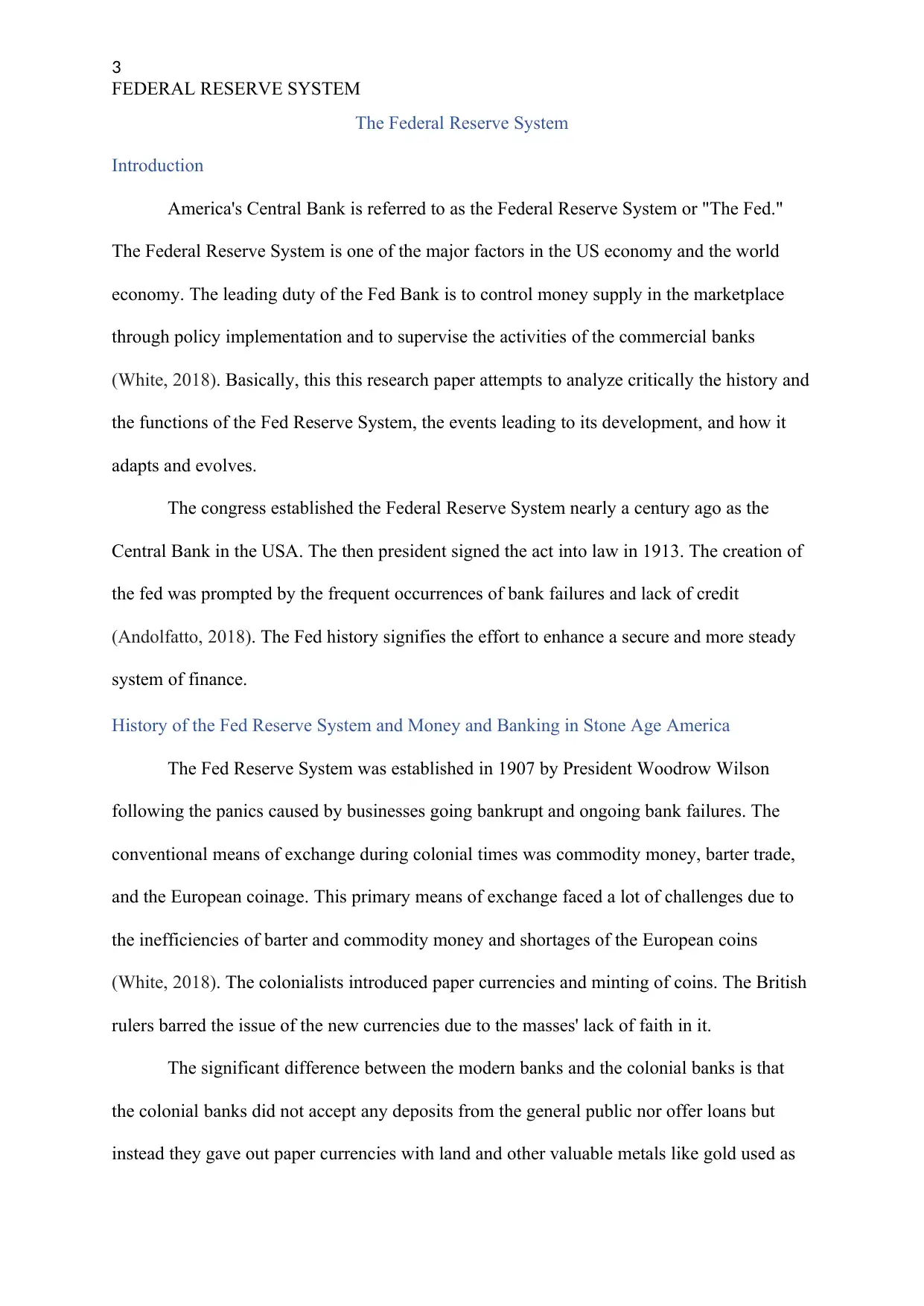
3
FEDERAL RESERVE SYSTEM
The Federal Reserve System
Introduction
America's Central Bank is referred to as the Federal Reserve System or "The Fed."
The Federal Reserve System is one of the major factors in the US economy and the world
economy. The leading duty of the Fed Bank is to control money supply in the marketplace
through policy implementation and to supervise the activities of the commercial banks
(White, 2018). Basically, this this research paper attempts to analyze critically the history and
the functions of the Fed Reserve System, the events leading to its development, and how it
adapts and evolves.
The congress established the Federal Reserve System nearly a century ago as the
Central Bank in the USA. The then president signed the act into law in 1913. The creation of
the fed was prompted by the frequent occurrences of bank failures and lack of credit
(Andolfatto, 2018). The Fed history signifies the effort to enhance a secure and more steady
system of finance.
History of the Fed Reserve System and Money and Banking in Stone Age America
The Fed Reserve System was established in 1907 by President Woodrow Wilson
following the panics caused by businesses going bankrupt and ongoing bank failures. The
conventional means of exchange during colonial times was commodity money, barter trade,
and the European coinage. This primary means of exchange faced a lot of challenges due to
the inefficiencies of barter and commodity money and shortages of the European coins
(White, 2018). The colonialists introduced paper currencies and minting of coins. The British
rulers barred the issue of the new currencies due to the masses' lack of faith in it.
The significant difference between the modern banks and the colonial banks is that
the colonial banks did not accept any deposits from the general public nor offer loans but
instead they gave out paper currencies with land and other valuable metals like gold used as
FEDERAL RESERVE SYSTEM
The Federal Reserve System
Introduction
America's Central Bank is referred to as the Federal Reserve System or "The Fed."
The Federal Reserve System is one of the major factors in the US economy and the world
economy. The leading duty of the Fed Bank is to control money supply in the marketplace
through policy implementation and to supervise the activities of the commercial banks
(White, 2018). Basically, this this research paper attempts to analyze critically the history and
the functions of the Fed Reserve System, the events leading to its development, and how it
adapts and evolves.
The congress established the Federal Reserve System nearly a century ago as the
Central Bank in the USA. The then president signed the act into law in 1913. The creation of
the fed was prompted by the frequent occurrences of bank failures and lack of credit
(Andolfatto, 2018). The Fed history signifies the effort to enhance a secure and more steady
system of finance.
History of the Fed Reserve System and Money and Banking in Stone Age America
The Fed Reserve System was established in 1907 by President Woodrow Wilson
following the panics caused by businesses going bankrupt and ongoing bank failures. The
conventional means of exchange during colonial times was commodity money, barter trade,
and the European coinage. This primary means of exchange faced a lot of challenges due to
the inefficiencies of barter and commodity money and shortages of the European coins
(White, 2018). The colonialists introduced paper currencies and minting of coins. The British
rulers barred the issue of the new currencies due to the masses' lack of faith in it.
The significant difference between the modern banks and the colonial banks is that
the colonial banks did not accept any deposits from the general public nor offer loans but
instead they gave out paper currencies with land and other valuable metals like gold used as
⊘ This is a preview!⊘
Do you want full access?
Subscribe today to unlock all pages.

Trusted by 1+ million students worldwide
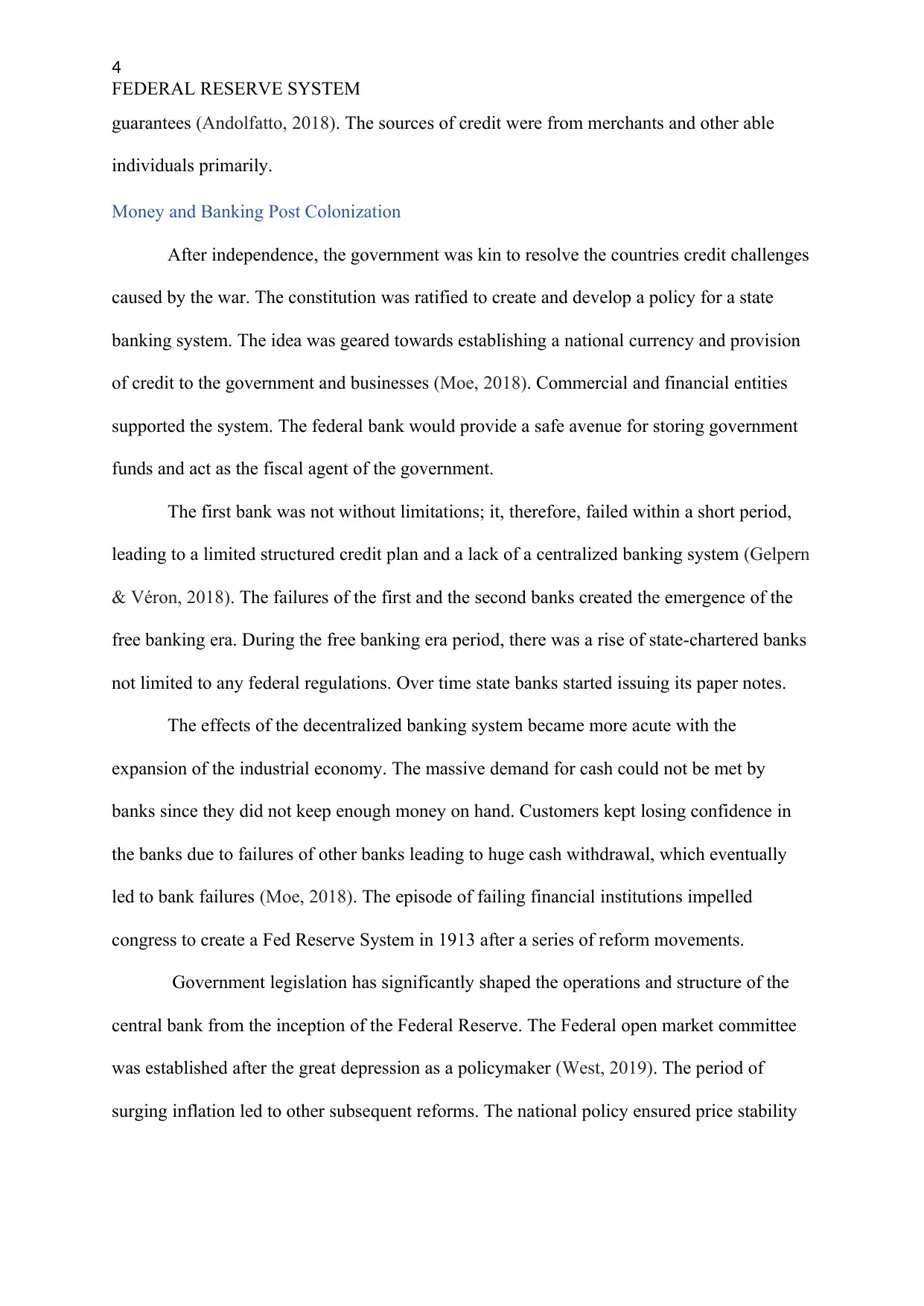
4
FEDERAL RESERVE SYSTEM
guarantees (Andolfatto, 2018). The sources of credit were from merchants and other able
individuals primarily.
Money and Banking Post Colonization
After independence, the government was kin to resolve the countries credit challenges
caused by the war. The constitution was ratified to create and develop a policy for a state
banking system. The idea was geared towards establishing a national currency and provision
of credit to the government and businesses (Moe, 2018). Commercial and financial entities
supported the system. The federal bank would provide a safe avenue for storing government
funds and act as the fiscal agent of the government.
The first bank was not without limitations; it, therefore, failed within a short period,
leading to a limited structured credit plan and a lack of a centralized banking system (Gelpern
& Véron, 2018). The failures of the first and the second banks created the emergence of the
free banking era. During the free banking era period, there was a rise of state-chartered banks
not limited to any federal regulations. Over time state banks started issuing its paper notes.
The effects of the decentralized banking system became more acute with the
expansion of the industrial economy. The massive demand for cash could not be met by
banks since they did not keep enough money on hand. Customers kept losing confidence in
the banks due to failures of other banks leading to huge cash withdrawal, which eventually
led to bank failures (Moe, 2018). The episode of failing financial institutions impelled
congress to create a Fed Reserve System in 1913 after a series of reform movements.
Government legislation has significantly shaped the operations and structure of the
central bank from the inception of the Federal Reserve. The Federal open market committee
was established after the great depression as a policymaker (West, 2019). The period of
surging inflation led to other subsequent reforms. The national policy ensured price stability
FEDERAL RESERVE SYSTEM
guarantees (Andolfatto, 2018). The sources of credit were from merchants and other able
individuals primarily.
Money and Banking Post Colonization
After independence, the government was kin to resolve the countries credit challenges
caused by the war. The constitution was ratified to create and develop a policy for a state
banking system. The idea was geared towards establishing a national currency and provision
of credit to the government and businesses (Moe, 2018). Commercial and financial entities
supported the system. The federal bank would provide a safe avenue for storing government
funds and act as the fiscal agent of the government.
The first bank was not without limitations; it, therefore, failed within a short period,
leading to a limited structured credit plan and a lack of a centralized banking system (Gelpern
& Véron, 2018). The failures of the first and the second banks created the emergence of the
free banking era. During the free banking era period, there was a rise of state-chartered banks
not limited to any federal regulations. Over time state banks started issuing its paper notes.
The effects of the decentralized banking system became more acute with the
expansion of the industrial economy. The massive demand for cash could not be met by
banks since they did not keep enough money on hand. Customers kept losing confidence in
the banks due to failures of other banks leading to huge cash withdrawal, which eventually
led to bank failures (Moe, 2018). The episode of failing financial institutions impelled
congress to create a Fed Reserve System in 1913 after a series of reform movements.
Government legislation has significantly shaped the operations and structure of the
central bank from the inception of the Federal Reserve. The Federal open market committee
was established after the great depression as a policymaker (West, 2019). The period of
surging inflation led to other subsequent reforms. The national policy ensured price stability
Paraphrase This Document
Need a fresh take? Get an instant paraphrase of this document with our AI Paraphraser
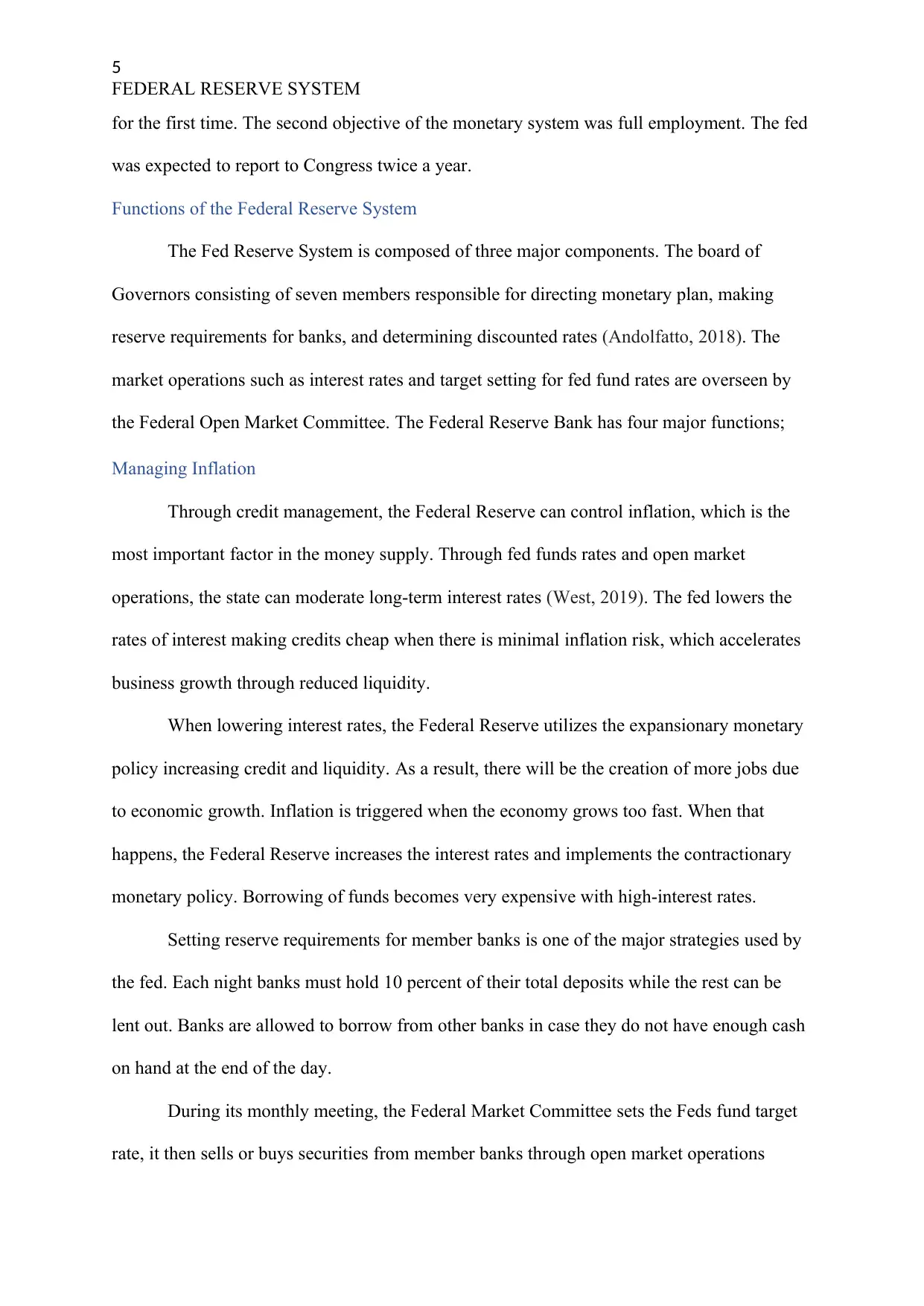
5
FEDERAL RESERVE SYSTEM
for the first time. The second objective of the monetary system was full employment. The fed
was expected to report to Congress twice a year.
Functions of the Federal Reserve System
The Fed Reserve System is composed of three major components. The board of
Governors consisting of seven members responsible for directing monetary plan, making
reserve requirements for banks, and determining discounted rates (Andolfatto, 2018). The
market operations such as interest rates and target setting for fed fund rates are overseen by
the Federal Open Market Committee. The Federal Reserve Bank has four major functions;
Managing Inflation
Through credit management, the Federal Reserve can control inflation, which is the
most important factor in the money supply. Through fed funds rates and open market
operations, the state can moderate long-term interest rates (West, 2019). The fed lowers the
rates of interest making credits cheap when there is minimal inflation risk, which accelerates
business growth through reduced liquidity.
When lowering interest rates, the Federal Reserve utilizes the expansionary monetary
policy increasing credit and liquidity. As a result, there will be the creation of more jobs due
to economic growth. Inflation is triggered when the economy grows too fast. When that
happens, the Federal Reserve increases the interest rates and implements the contractionary
monetary policy. Borrowing of funds becomes very expensive with high-interest rates.
Setting reserve requirements for member banks is one of the major strategies used by
the fed. Each night banks must hold 10 percent of their total deposits while the rest can be
lent out. Banks are allowed to borrow from other banks in case they do not have enough cash
on hand at the end of the day.
During its monthly meeting, the Federal Market Committee sets the Feds fund target
rate, it then sells or buys securities from member banks through open market operations
FEDERAL RESERVE SYSTEM
for the first time. The second objective of the monetary system was full employment. The fed
was expected to report to Congress twice a year.
Functions of the Federal Reserve System
The Fed Reserve System is composed of three major components. The board of
Governors consisting of seven members responsible for directing monetary plan, making
reserve requirements for banks, and determining discounted rates (Andolfatto, 2018). The
market operations such as interest rates and target setting for fed fund rates are overseen by
the Federal Open Market Committee. The Federal Reserve Bank has four major functions;
Managing Inflation
Through credit management, the Federal Reserve can control inflation, which is the
most important factor in the money supply. Through fed funds rates and open market
operations, the state can moderate long-term interest rates (West, 2019). The fed lowers the
rates of interest making credits cheap when there is minimal inflation risk, which accelerates
business growth through reduced liquidity.
When lowering interest rates, the Federal Reserve utilizes the expansionary monetary
policy increasing credit and liquidity. As a result, there will be the creation of more jobs due
to economic growth. Inflation is triggered when the economy grows too fast. When that
happens, the Federal Reserve increases the interest rates and implements the contractionary
monetary policy. Borrowing of funds becomes very expensive with high-interest rates.
Setting reserve requirements for member banks is one of the major strategies used by
the fed. Each night banks must hold 10 percent of their total deposits while the rest can be
lent out. Banks are allowed to borrow from other banks in case they do not have enough cash
on hand at the end of the day.
During its monthly meeting, the Federal Market Committee sets the Feds fund target
rate, it then sells or buys securities from member banks through open market operations
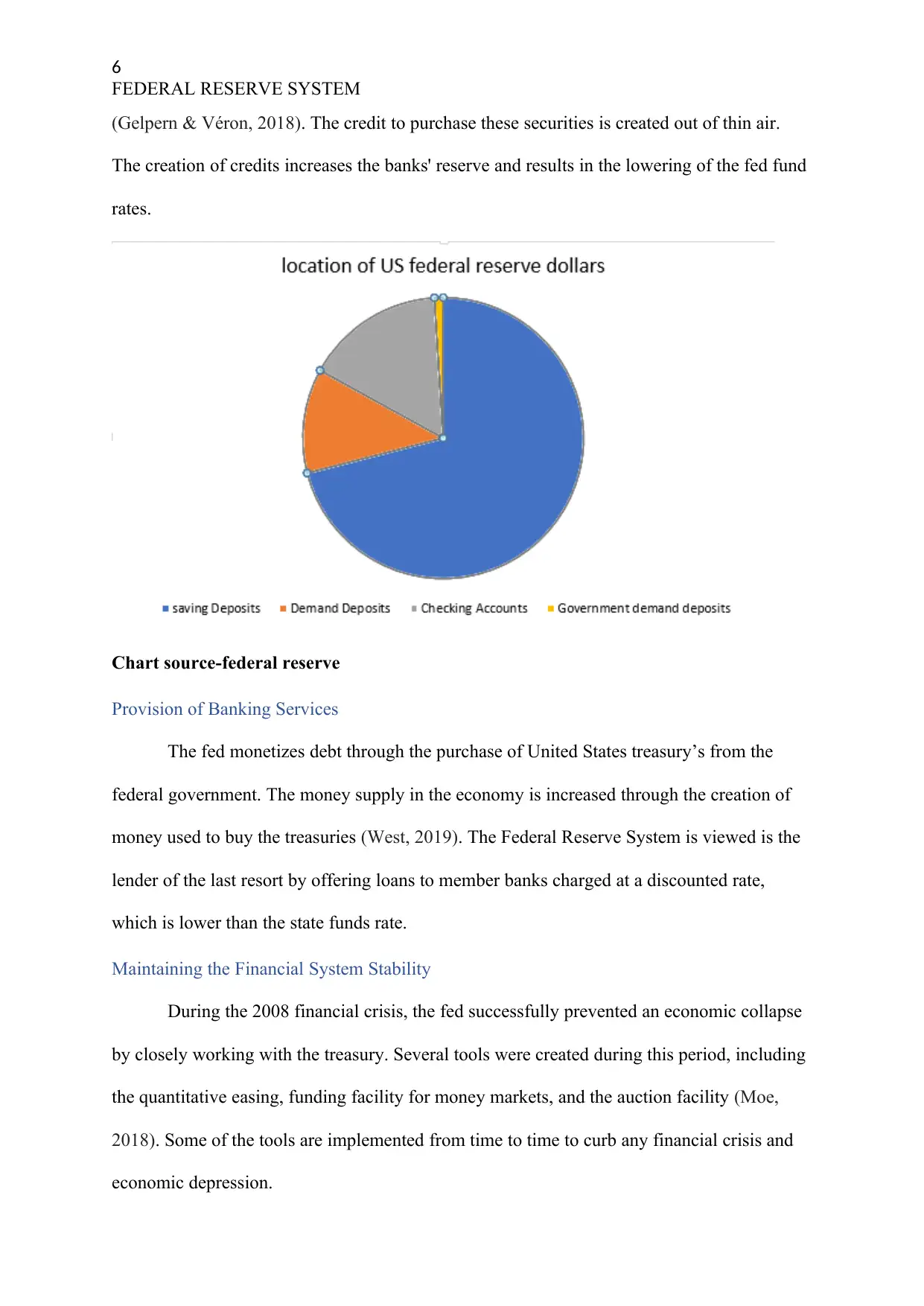
6
FEDERAL RESERVE SYSTEM
(Gelpern & Véron, 2018). The credit to purchase these securities is created out of thin air.
The creation of credits increases the banks' reserve and results in the lowering of the fed fund
rates.
Chart source-federal reserve
Provision of Banking Services
The fed monetizes debt through the purchase of United States treasury’s from the
federal government. The money supply in the economy is increased through the creation of
money used to buy the treasuries (West, 2019). The Federal Reserve System is viewed is the
lender of the last resort by offering loans to member banks charged at a discounted rate,
which is lower than the state funds rate.
Maintaining the Financial System Stability
During the 2008 financial crisis, the fed successfully prevented an economic collapse
by closely working with the treasury. Several tools were created during this period, including
the quantitative easing, funding facility for money markets, and the auction facility (Moe,
2018). Some of the tools are implemented from time to time to curb any financial crisis and
economic depression.
FEDERAL RESERVE SYSTEM
(Gelpern & Véron, 2018). The credit to purchase these securities is created out of thin air.
The creation of credits increases the banks' reserve and results in the lowering of the fed fund
rates.
Chart source-federal reserve
Provision of Banking Services
The fed monetizes debt through the purchase of United States treasury’s from the
federal government. The money supply in the economy is increased through the creation of
money used to buy the treasuries (West, 2019). The Federal Reserve System is viewed is the
lender of the last resort by offering loans to member banks charged at a discounted rate,
which is lower than the state funds rate.
Maintaining the Financial System Stability
During the 2008 financial crisis, the fed successfully prevented an economic collapse
by closely working with the treasury. Several tools were created during this period, including
the quantitative easing, funding facility for money markets, and the auction facility (Moe,
2018). Some of the tools are implemented from time to time to curb any financial crisis and
economic depression.
⊘ This is a preview!⊘
Do you want full access?
Subscribe today to unlock all pages.

Trusted by 1+ million students worldwide
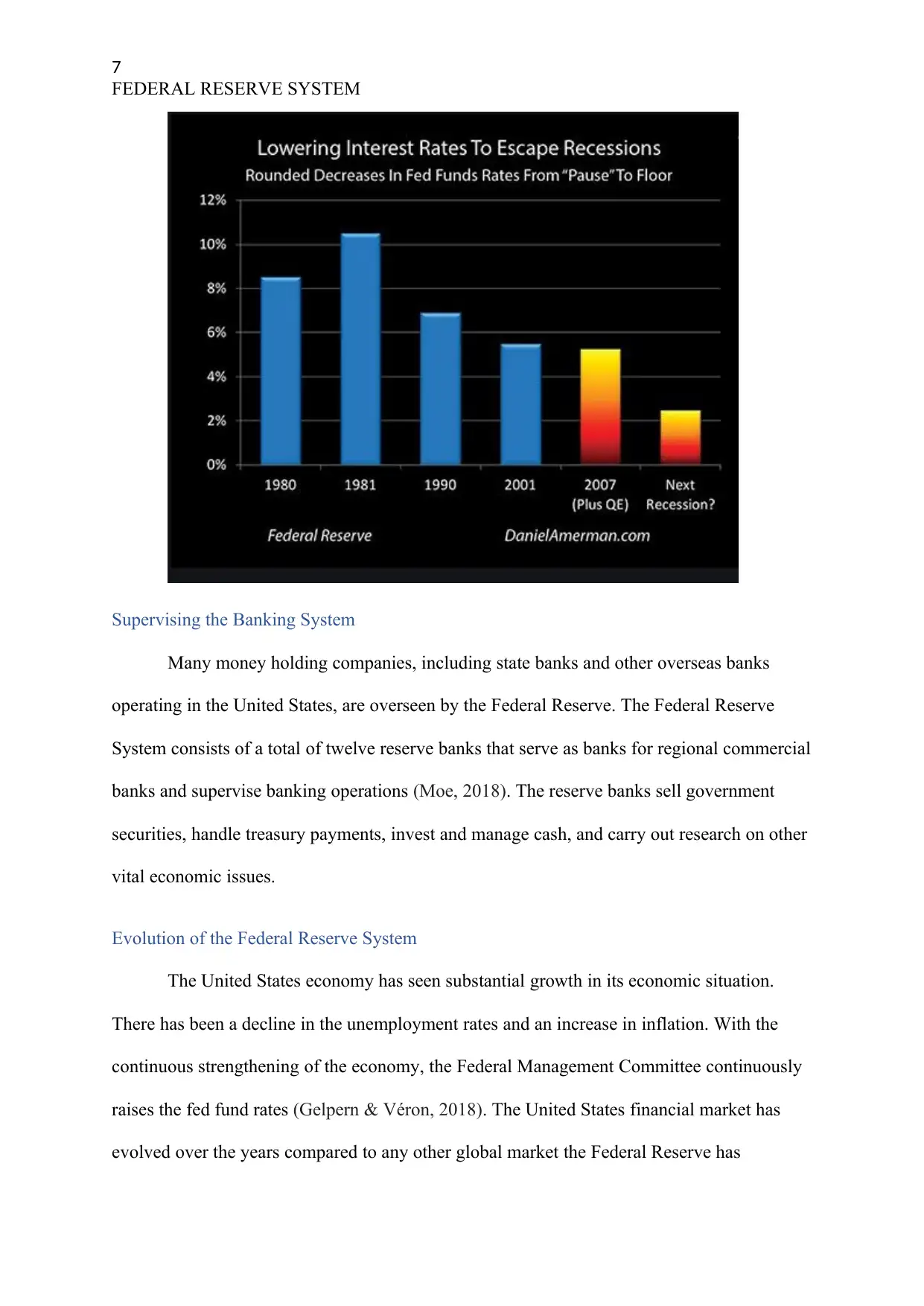
7
FEDERAL RESERVE SYSTEM
Supervising the Banking System
Many money holding companies, including state banks and other overseas banks
operating in the United States, are overseen by the Federal Reserve. The Federal Reserve
System consists of a total of twelve reserve banks that serve as banks for regional commercial
banks and supervise banking operations (Moe, 2018). The reserve banks sell government
securities, handle treasury payments, invest and manage cash, and carry out research on other
vital economic issues.
Evolution of the Federal Reserve System
The United States economy has seen substantial growth in its economic situation.
There has been a decline in the unemployment rates and an increase in inflation. With the
continuous strengthening of the economy, the Federal Management Committee continuously
raises the fed fund rates (Gelpern & Véron, 2018). The United States financial market has
evolved over the years compared to any other global market the Federal Reserve has
FEDERAL RESERVE SYSTEM
Supervising the Banking System
Many money holding companies, including state banks and other overseas banks
operating in the United States, are overseen by the Federal Reserve. The Federal Reserve
System consists of a total of twelve reserve banks that serve as banks for regional commercial
banks and supervise banking operations (Moe, 2018). The reserve banks sell government
securities, handle treasury payments, invest and manage cash, and carry out research on other
vital economic issues.
Evolution of the Federal Reserve System
The United States economy has seen substantial growth in its economic situation.
There has been a decline in the unemployment rates and an increase in inflation. With the
continuous strengthening of the economy, the Federal Management Committee continuously
raises the fed fund rates (Gelpern & Véron, 2018). The United States financial market has
evolved over the years compared to any other global market the Federal Reserve has
Paraphrase This Document
Need a fresh take? Get an instant paraphrase of this document with our AI Paraphraser
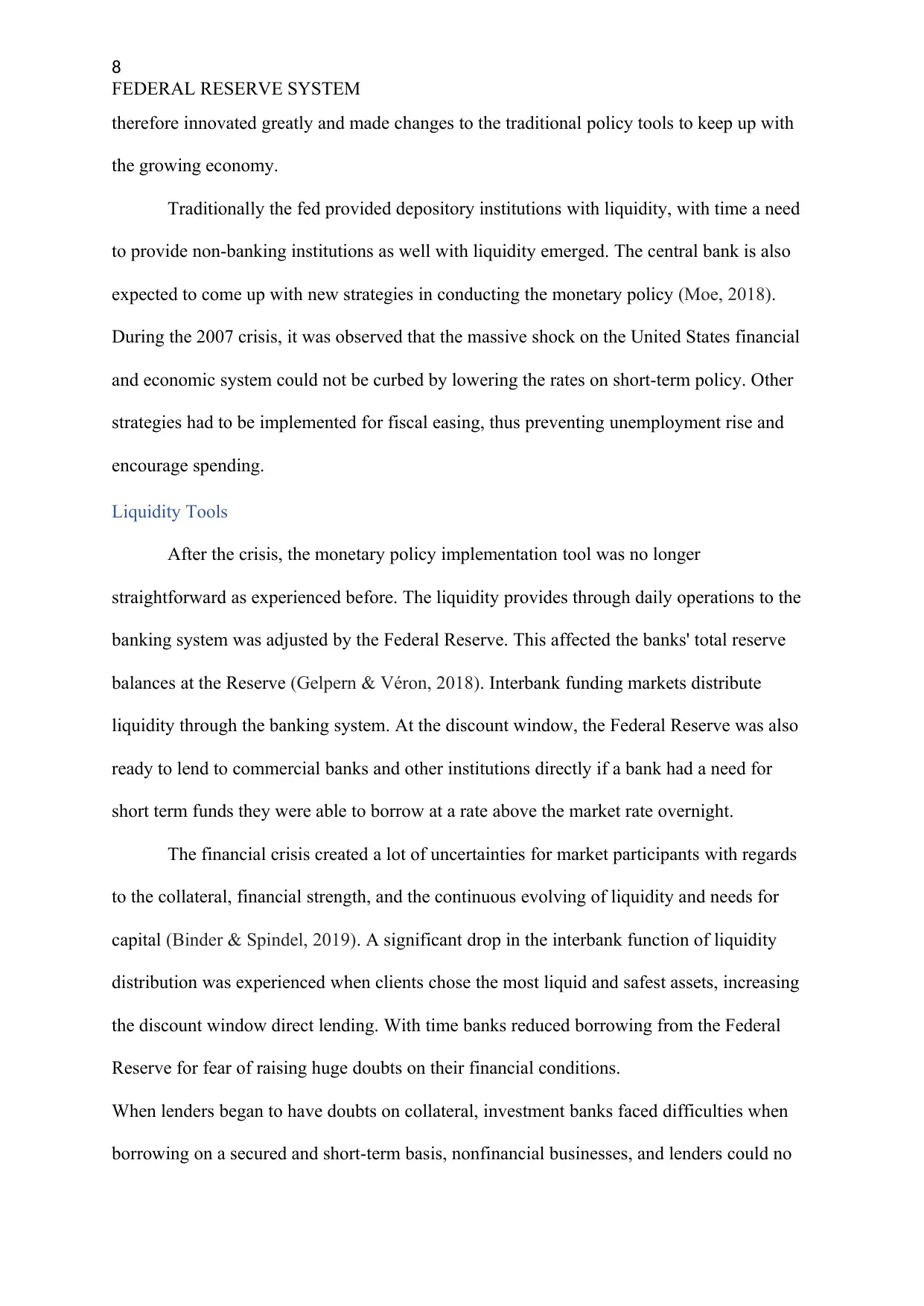
8
FEDERAL RESERVE SYSTEM
therefore innovated greatly and made changes to the traditional policy tools to keep up with
the growing economy.
Traditionally the fed provided depository institutions with liquidity, with time a need
to provide non-banking institutions as well with liquidity emerged. The central bank is also
expected to come up with new strategies in conducting the monetary policy (Moe, 2018).
During the 2007 crisis, it was observed that the massive shock on the United States financial
and economic system could not be curbed by lowering the rates on short-term policy. Other
strategies had to be implemented for fiscal easing, thus preventing unemployment rise and
encourage spending.
Liquidity Tools
After the crisis, the monetary policy implementation tool was no longer
straightforward as experienced before. The liquidity provides through daily operations to the
banking system was adjusted by the Federal Reserve. This affected the banks' total reserve
balances at the Reserve (Gelpern & Véron, 2018). Interbank funding markets distribute
liquidity through the banking system. At the discount window, the Federal Reserve was also
ready to lend to commercial banks and other institutions directly if a bank had a need for
short term funds they were able to borrow at a rate above the market rate overnight.
The financial crisis created a lot of uncertainties for market participants with regards
to the collateral, financial strength, and the continuous evolving of liquidity and needs for
capital (Binder & Spindel, 2019). A significant drop in the interbank function of liquidity
distribution was experienced when clients chose the most liquid and safest assets, increasing
the discount window direct lending. With time banks reduced borrowing from the Federal
Reserve for fear of raising huge doubts on their financial conditions.
When lenders began to have doubts on collateral, investment banks faced difficulties when
borrowing on a secured and short-term basis, nonfinancial businesses, and lenders could no
FEDERAL RESERVE SYSTEM
therefore innovated greatly and made changes to the traditional policy tools to keep up with
the growing economy.
Traditionally the fed provided depository institutions with liquidity, with time a need
to provide non-banking institutions as well with liquidity emerged. The central bank is also
expected to come up with new strategies in conducting the monetary policy (Moe, 2018).
During the 2007 crisis, it was observed that the massive shock on the United States financial
and economic system could not be curbed by lowering the rates on short-term policy. Other
strategies had to be implemented for fiscal easing, thus preventing unemployment rise and
encourage spending.
Liquidity Tools
After the crisis, the monetary policy implementation tool was no longer
straightforward as experienced before. The liquidity provides through daily operations to the
banking system was adjusted by the Federal Reserve. This affected the banks' total reserve
balances at the Reserve (Gelpern & Véron, 2018). Interbank funding markets distribute
liquidity through the banking system. At the discount window, the Federal Reserve was also
ready to lend to commercial banks and other institutions directly if a bank had a need for
short term funds they were able to borrow at a rate above the market rate overnight.
The financial crisis created a lot of uncertainties for market participants with regards
to the collateral, financial strength, and the continuous evolving of liquidity and needs for
capital (Binder & Spindel, 2019). A significant drop in the interbank function of liquidity
distribution was experienced when clients chose the most liquid and safest assets, increasing
the discount window direct lending. With time banks reduced borrowing from the Federal
Reserve for fear of raising huge doubts on their financial conditions.
When lenders began to have doubts on collateral, investment banks faced difficulties when
borrowing on a secured and short-term basis, nonfinancial businesses, and lenders could no
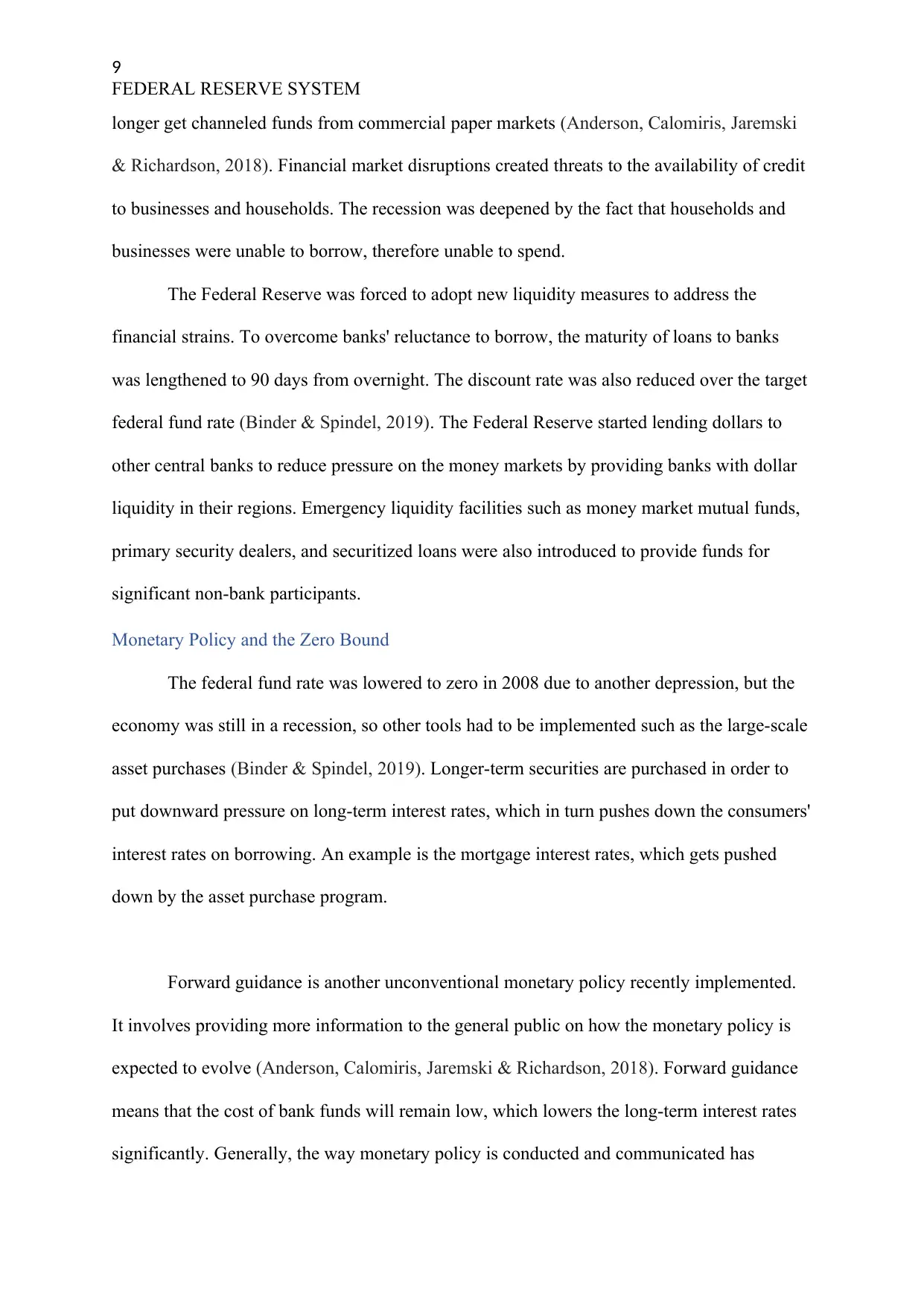
9
FEDERAL RESERVE SYSTEM
longer get channeled funds from commercial paper markets (Anderson, Calomiris, Jaremski
& Richardson, 2018). Financial market disruptions created threats to the availability of credit
to businesses and households. The recession was deepened by the fact that households and
businesses were unable to borrow, therefore unable to spend.
The Federal Reserve was forced to adopt new liquidity measures to address the
financial strains. To overcome banks' reluctance to borrow, the maturity of loans to banks
was lengthened to 90 days from overnight. The discount rate was also reduced over the target
federal fund rate (Binder & Spindel, 2019). The Federal Reserve started lending dollars to
other central banks to reduce pressure on the money markets by providing banks with dollar
liquidity in their regions. Emergency liquidity facilities such as money market mutual funds,
primary security dealers, and securitized loans were also introduced to provide funds for
significant non-bank participants.
Monetary Policy and the Zero Bound
The federal fund rate was lowered to zero in 2008 due to another depression, but the
economy was still in a recession, so other tools had to be implemented such as the large-scale
asset purchases (Binder & Spindel, 2019). Longer-term securities are purchased in order to
put downward pressure on long-term interest rates, which in turn pushes down the consumers'
interest rates on borrowing. An example is the mortgage interest rates, which gets pushed
down by the asset purchase program.
Forward guidance is another unconventional monetary policy recently implemented.
It involves providing more information to the general public on how the monetary policy is
expected to evolve (Anderson, Calomiris, Jaremski & Richardson, 2018). Forward guidance
means that the cost of bank funds will remain low, which lowers the long-term interest rates
significantly. Generally, the way monetary policy is conducted and communicated has
FEDERAL RESERVE SYSTEM
longer get channeled funds from commercial paper markets (Anderson, Calomiris, Jaremski
& Richardson, 2018). Financial market disruptions created threats to the availability of credit
to businesses and households. The recession was deepened by the fact that households and
businesses were unable to borrow, therefore unable to spend.
The Federal Reserve was forced to adopt new liquidity measures to address the
financial strains. To overcome banks' reluctance to borrow, the maturity of loans to banks
was lengthened to 90 days from overnight. The discount rate was also reduced over the target
federal fund rate (Binder & Spindel, 2019). The Federal Reserve started lending dollars to
other central banks to reduce pressure on the money markets by providing banks with dollar
liquidity in their regions. Emergency liquidity facilities such as money market mutual funds,
primary security dealers, and securitized loans were also introduced to provide funds for
significant non-bank participants.
Monetary Policy and the Zero Bound
The federal fund rate was lowered to zero in 2008 due to another depression, but the
economy was still in a recession, so other tools had to be implemented such as the large-scale
asset purchases (Binder & Spindel, 2019). Longer-term securities are purchased in order to
put downward pressure on long-term interest rates, which in turn pushes down the consumers'
interest rates on borrowing. An example is the mortgage interest rates, which gets pushed
down by the asset purchase program.
Forward guidance is another unconventional monetary policy recently implemented.
It involves providing more information to the general public on how the monetary policy is
expected to evolve (Anderson, Calomiris, Jaremski & Richardson, 2018). Forward guidance
means that the cost of bank funds will remain low, which lowers the long-term interest rates
significantly. Generally, the way monetary policy is conducted and communicated has
⊘ This is a preview!⊘
Do you want full access?
Subscribe today to unlock all pages.

Trusted by 1+ million students worldwide
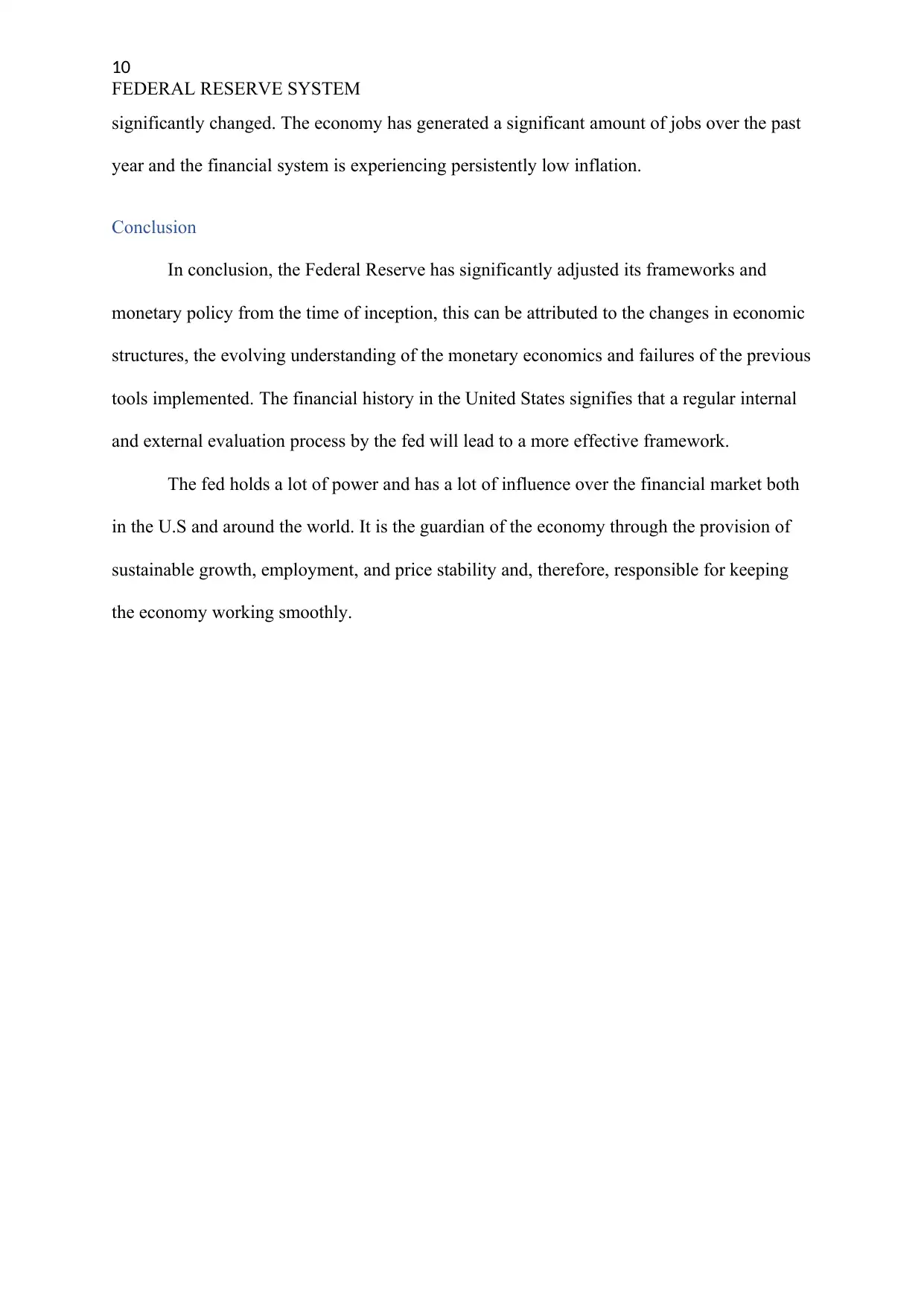
10
FEDERAL RESERVE SYSTEM
significantly changed. The economy has generated a significant amount of jobs over the past
year and the financial system is experiencing persistently low inflation.
Conclusion
In conclusion, the Federal Reserve has significantly adjusted its frameworks and
monetary policy from the time of inception, this can be attributed to the changes in economic
structures, the evolving understanding of the monetary economics and failures of the previous
tools implemented. The financial history in the United States signifies that a regular internal
and external evaluation process by the fed will lead to a more effective framework.
The fed holds a lot of power and has a lot of influence over the financial market both
in the U.S and around the world. It is the guardian of the economy through the provision of
sustainable growth, employment, and price stability and, therefore, responsible for keeping
the economy working smoothly.
FEDERAL RESERVE SYSTEM
significantly changed. The economy has generated a significant amount of jobs over the past
year and the financial system is experiencing persistently low inflation.
Conclusion
In conclusion, the Federal Reserve has significantly adjusted its frameworks and
monetary policy from the time of inception, this can be attributed to the changes in economic
structures, the evolving understanding of the monetary economics and failures of the previous
tools implemented. The financial history in the United States signifies that a regular internal
and external evaluation process by the fed will lead to a more effective framework.
The fed holds a lot of power and has a lot of influence over the financial market both
in the U.S and around the world. It is the guardian of the economy through the provision of
sustainable growth, employment, and price stability and, therefore, responsible for keeping
the economy working smoothly.
Paraphrase This Document
Need a fresh take? Get an instant paraphrase of this document with our AI Paraphraser
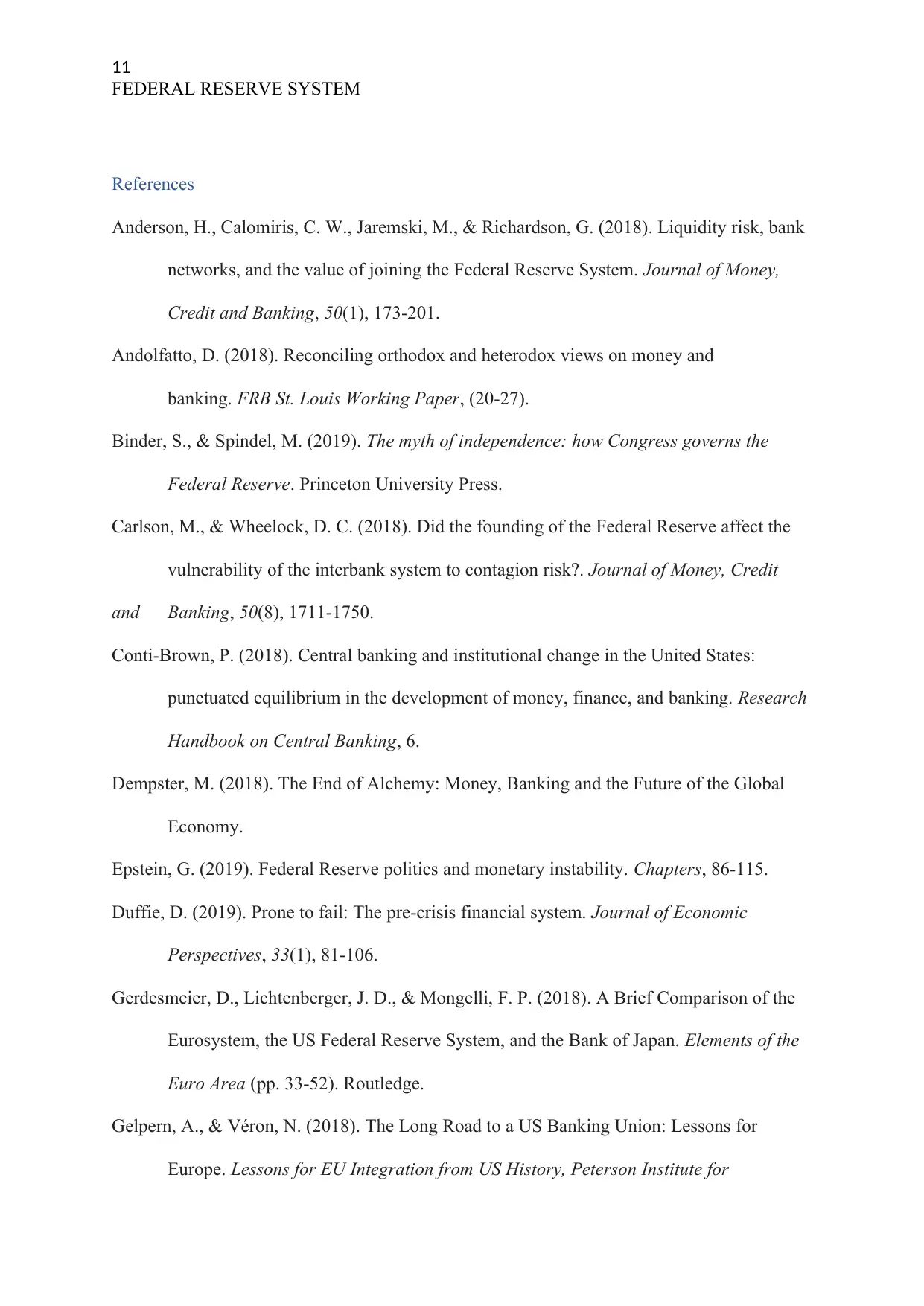
11
FEDERAL RESERVE SYSTEM
References
Anderson, H., Calomiris, C. W., Jaremski, M., & Richardson, G. (2018). Liquidity risk, bank
networks, and the value of joining the Federal Reserve System. Journal of Money,
Credit and Banking, 50(1), 173-201.
Andolfatto, D. (2018). Reconciling orthodox and heterodox views on money and
banking. FRB St. Louis Working Paper, (20-27).
Binder, S., & Spindel, M. (2019). The myth of independence: how Congress governs the
Federal Reserve. Princeton University Press.
Carlson, M., & Wheelock, D. C. (2018). Did the founding of the Federal Reserve affect the
vulnerability of the interbank system to contagion risk?. Journal of Money, Credit
and Banking, 50(8), 1711-1750.
Conti-Brown, P. (2018). Central banking and institutional change in the United States:
punctuated equilibrium in the development of money, finance, and banking. Research
Handbook on Central Banking, 6.
Dempster, M. (2018). The End of Alchemy: Money, Banking and the Future of the Global
Economy.
Epstein, G. (2019). Federal Reserve politics and monetary instability. Chapters, 86-115.
Duffie, D. (2019). Prone to fail: The pre-crisis financial system. Journal of Economic
Perspectives, 33(1), 81-106.
Gerdesmeier, D., Lichtenberger, J. D., & Mongelli, F. P. (2018). A Brief Comparison of the
Eurosystem, the US Federal Reserve System, and the Bank of Japan. Elements of the
Euro Area (pp. 33-52). Routledge.
Gelpern, A., & Véron, N. (2018). The Long Road to a US Banking Union: Lessons for
Europe. Lessons for EU Integration from US History, Peterson Institute for
FEDERAL RESERVE SYSTEM
References
Anderson, H., Calomiris, C. W., Jaremski, M., & Richardson, G. (2018). Liquidity risk, bank
networks, and the value of joining the Federal Reserve System. Journal of Money,
Credit and Banking, 50(1), 173-201.
Andolfatto, D. (2018). Reconciling orthodox and heterodox views on money and
banking. FRB St. Louis Working Paper, (20-27).
Binder, S., & Spindel, M. (2019). The myth of independence: how Congress governs the
Federal Reserve. Princeton University Press.
Carlson, M., & Wheelock, D. C. (2018). Did the founding of the Federal Reserve affect the
vulnerability of the interbank system to contagion risk?. Journal of Money, Credit
and Banking, 50(8), 1711-1750.
Conti-Brown, P. (2018). Central banking and institutional change in the United States:
punctuated equilibrium in the development of money, finance, and banking. Research
Handbook on Central Banking, 6.
Dempster, M. (2018). The End of Alchemy: Money, Banking and the Future of the Global
Economy.
Epstein, G. (2019). Federal Reserve politics and monetary instability. Chapters, 86-115.
Duffie, D. (2019). Prone to fail: The pre-crisis financial system. Journal of Economic
Perspectives, 33(1), 81-106.
Gerdesmeier, D., Lichtenberger, J. D., & Mongelli, F. P. (2018). A Brief Comparison of the
Eurosystem, the US Federal Reserve System, and the Bank of Japan. Elements of the
Euro Area (pp. 33-52). Routledge.
Gelpern, A., & Véron, N. (2018). The Long Road to a US Banking Union: Lessons for
Europe. Lessons for EU Integration from US History, Peterson Institute for
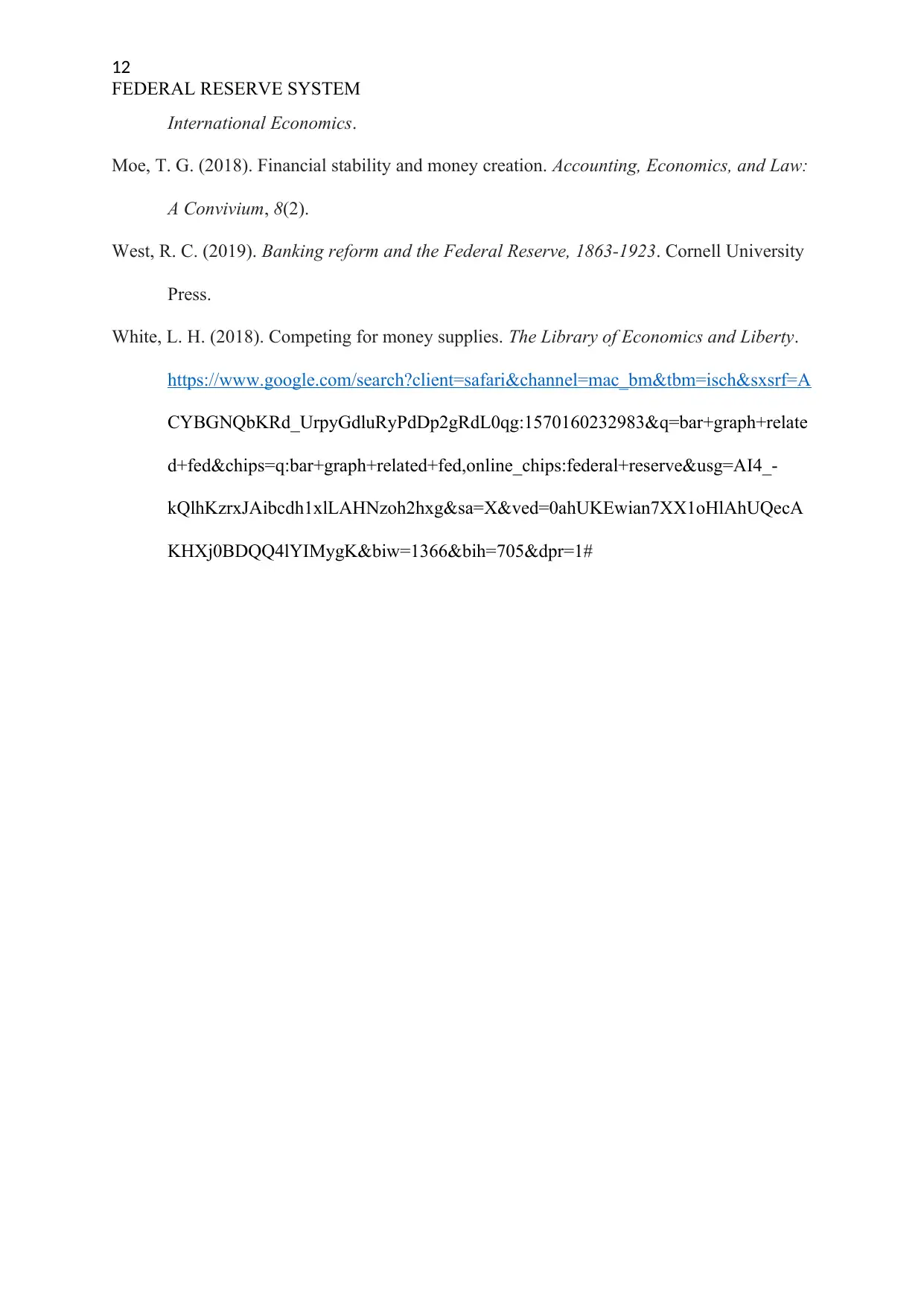
12
FEDERAL RESERVE SYSTEM
International Economics.
Moe, T. G. (2018). Financial stability and money creation. Accounting, Economics, and Law:
A Convivium, 8(2).
West, R. C. (2019). Banking reform and the Federal Reserve, 1863-1923. Cornell University
Press.
White, L. H. (2018). Competing for money supplies. The Library of Economics and Liberty.
https://www.google.com/search?client=safari&channel=mac_bm&tbm=isch&sxsrf=A
CYBGNQbKRd_UrpyGdluRyPdDp2gRdL0qg:1570160232983&q=bar+graph+relate
d+fed&chips=q:bar+graph+related+fed,online_chips:federal+reserve&usg=AI4_-
kQlhKzrxJAibcdh1xlLAHNzoh2hxg&sa=X&ved=0ahUKEwian7XX1oHlAhUQecA
KHXj0BDQQ4lYIMygK&biw=1366&bih=705&dpr=1#
FEDERAL RESERVE SYSTEM
International Economics.
Moe, T. G. (2018). Financial stability and money creation. Accounting, Economics, and Law:
A Convivium, 8(2).
West, R. C. (2019). Banking reform and the Federal Reserve, 1863-1923. Cornell University
Press.
White, L. H. (2018). Competing for money supplies. The Library of Economics and Liberty.
https://www.google.com/search?client=safari&channel=mac_bm&tbm=isch&sxsrf=A
CYBGNQbKRd_UrpyGdluRyPdDp2gRdL0qg:1570160232983&q=bar+graph+relate
d+fed&chips=q:bar+graph+related+fed,online_chips:federal+reserve&usg=AI4_-
kQlhKzrxJAibcdh1xlLAHNzoh2hxg&sa=X&ved=0ahUKEwian7XX1oHlAhUQecA
KHXj0BDQQ4lYIMygK&biw=1366&bih=705&dpr=1#
⊘ This is a preview!⊘
Do you want full access?
Subscribe today to unlock all pages.

Trusted by 1+ million students worldwide
1 out of 12
Your All-in-One AI-Powered Toolkit for Academic Success.
+13062052269
info@desklib.com
Available 24*7 on WhatsApp / Email
![[object Object]](/_next/static/media/star-bottom.7253800d.svg)
Unlock your academic potential
Copyright © 2020–2025 A2Z Services. All Rights Reserved. Developed and managed by ZUCOL.